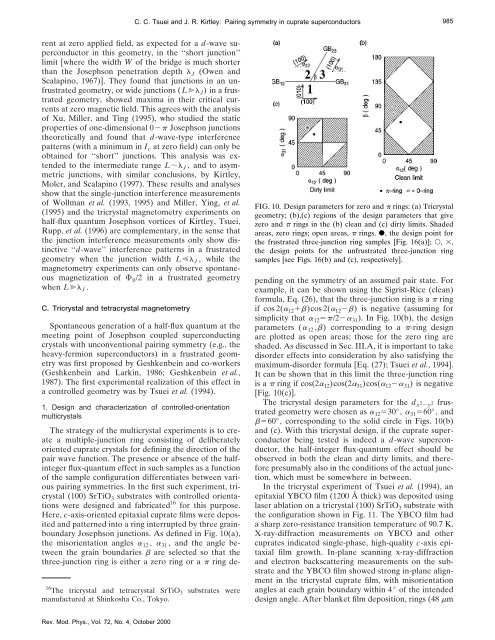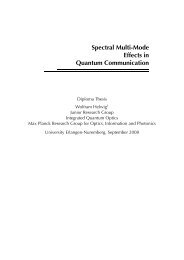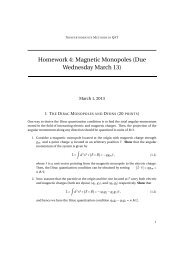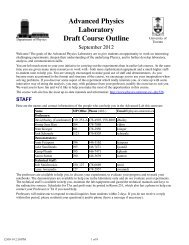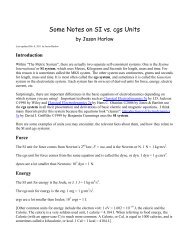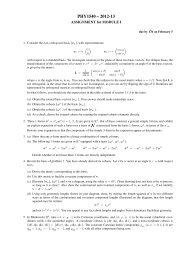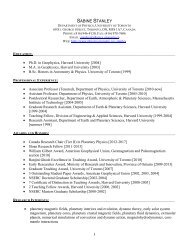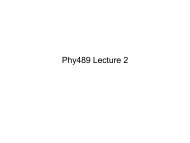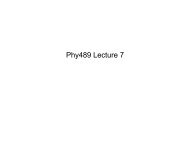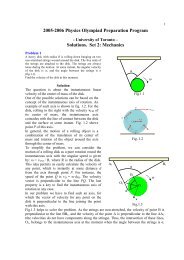Kirtley and Tsuei - Physics
Kirtley and Tsuei - Physics
Kirtley and Tsuei - Physics
Create successful ePaper yourself
Turn your PDF publications into a flip-book with our unique Google optimized e-Paper software.
C. C. <strong>Tsuei</strong> <strong>and</strong> J. R. <strong>Kirtley</strong>: Pairing symmetry in cuprate superconductors<br />
985<br />
rent at zero applied field, as expected for a d-wave superconductor<br />
in this geometry, in the ‘‘short junction’’<br />
limit [where the width W of the bridge is much shorter<br />
than the Josephson penetration depth J (Owen <strong>and</strong><br />
Scalapino, 1967)]. They found that junctions in an unfrustrated<br />
geometry, or wide junctions (L J ) in a frustrated<br />
geometry, showed maxima in their critical currents<br />
at zero magnetic field. This agrees with the analysis<br />
of Xu, Miller, <strong>and</strong> Ting (1995), who studied the static<br />
properties of one-dimensional 0 Josephson junctions<br />
theoretically <strong>and</strong> found that d-wave-type interference<br />
patterns (with a minimum in I c at zero field) can only be<br />
obtained for ‘‘short’’ junctions. This analysis was extended<br />
to the intermediate range L J , <strong>and</strong> to asymmetric<br />
junctions, with similar conclusions, by <strong>Kirtley</strong>,<br />
Moler, <strong>and</strong> Scalapino (1997). These results <strong>and</strong> analyses<br />
show that the single-junction interference measurements<br />
of Wollman et al. (1993, 1995) <strong>and</strong> Miller, Ying, et al.<br />
(1995) <strong>and</strong> the tricrystal magnetometry experiments on<br />
half-flux quantum Josephson vortices of <strong>Kirtley</strong>, <strong>Tsuei</strong>,<br />
Rupp, et al. (1996) are complementary, in the sense that<br />
the junction interference measurements only show distinctive<br />
‘‘d-wave’’ interference patterns in a frustrated<br />
geometry when the junction width L J , while the<br />
magnetometry experiments can only observe spontaneous<br />
magnetization of 0 /2 in a frustrated geometry<br />
when L J .<br />
C. Tricrystal <strong>and</strong> tetracrystal magnetometry<br />
Spontaneous generation of a half-flux quantum at the<br />
meeting point of Josephson coupled superconducting<br />
crystals with unconventional pairing symmetry (e.g., the<br />
heavy-fermion superconductors) in a frustrated geometry<br />
was first proposed by Geshkenbein <strong>and</strong> co-workers<br />
(Geshkenbein <strong>and</strong> Larkin, 1986; Geshkenbein et al.,<br />
1987). The first experimental realization of this effect in<br />
a controlled geometry was by <strong>Tsuei</strong> et al. (1994).<br />
1. Design <strong>and</strong> characterization of controlled-orientation<br />
multicrystals<br />
The strategy of the multicrystal experiments is to create<br />
a multiple-junction ring consisting of deliberately<br />
oriented cuprate crystals for defining the direction of the<br />
pair wave function. The presence or absence of the halfinteger<br />
flux-quantum effect in such samples as a function<br />
of the sample configuration differentiates between various<br />
pairing symmetries. In the first such experiment, tricrystal<br />
(100) SrTiO 3 substrates with controlled orientations<br />
were designed <strong>and</strong> fabricated 16 for this purpose.<br />
Here, c-axis-oriented epitaxial cuprate films were deposited<br />
<strong>and</strong> patterned into a ring interrupted by three grainboundary<br />
Josephson junctions. As defined in Fig. 10(a),<br />
the misorientation angles 12 , 31 , <strong>and</strong> the angle between<br />
the grain boundaries are selected so that the<br />
three-junction ring is either a zero ring or a ring de-<br />
16 The tricrystal <strong>and</strong> tetracrystal SrTiO 3 substrates were<br />
manufactured at Shinkosha Co., Tokyo.<br />
FIG. 10. Design parameters for zero <strong>and</strong> rings: (a) Tricrystal<br />
geometry; (b),(c) regions of the design parameters that give<br />
zero <strong>and</strong> rings in the (b) clean <strong>and</strong> (c) dirty limits. Shaded<br />
areas, zero rings; open areas, rings. , the design point for<br />
the frustrated three-junction ring samples [Fig. 16(a)]; , ,<br />
the design points for the unfrustrated three-junction ring<br />
samples [see Figs. 16(b) <strong>and</strong> (c), respectively].<br />
pending on the symmetry of an assumed pair state. For<br />
example, it can be shown using the Sigrist-Rice (clean)<br />
formula, Eq. (26), that the three-junction ring is a ring<br />
if cos 2( 12 )cos 2( 12 ) is negative (assuming for<br />
simplicity that 12 /2 31 ). In Fig. 10(b), the design<br />
parameters ( 12 ,) corresponding to a -ring design<br />
are plotted as open areas; those for the zero ring are<br />
shaded. As discussed in Sec. III.A, it is important to take<br />
disorder effects into consideration by also satisfying the<br />
maximum-disorder formula [Eq. (27); <strong>Tsuei</strong> et al., 1994].<br />
It can be shown that in this limit the three-junction ring<br />
is a ring if cos(2 12 )cos(2 31 )cos( 12 31 ) is negative<br />
[Fig. 10(c)].<br />
The tricrystal design parameters for the d x 2 y 2 frustrated<br />
geometry were chosen as 12 30°, 31 60°, <strong>and</strong><br />
60°, corresponding to the solid circle in Figs. 10(b)<br />
<strong>and</strong> (c). With this tricrystal design, if the cuprate superconductor<br />
being tested is indeed a d-wave superconductor,<br />
the half-integer flux-quantum effect should be<br />
observed in both the clean <strong>and</strong> dirty limits, <strong>and</strong> therefore<br />
presumably also in the conditions of the actual junction,<br />
which must be somewhere in between.<br />
In the tricrystal experiment of <strong>Tsuei</strong> et al. (1994), an<br />
epitaxial YBCO film (1200 Å thick) was deposited using<br />
laser ablation on a tricrystal (100) SrTiO 3 substrate with<br />
the configuration shown in Fig. 11. The YBCO film had<br />
a sharp zero-resistance transition temperature of 90.7 K.<br />
X-ray-diffraction measurements on YBCO <strong>and</strong> other<br />
cuprates indicated single-phase, high-quality c-axis epitaxial<br />
film growth. In-plane scanning x-ray-diffraction<br />
<strong>and</strong> electron backscattering measurements on the substrate<br />
<strong>and</strong> the YBCO film showed strong in-plane alignment<br />
in the tricrystal cuprate film, with misorientation<br />
angles at each grain boundary within 4° of the intended<br />
design angle. After blanket film deposition, rings (48 m<br />
Rev. Mod. Phys., Vol. 72, No. 4, October 2000


